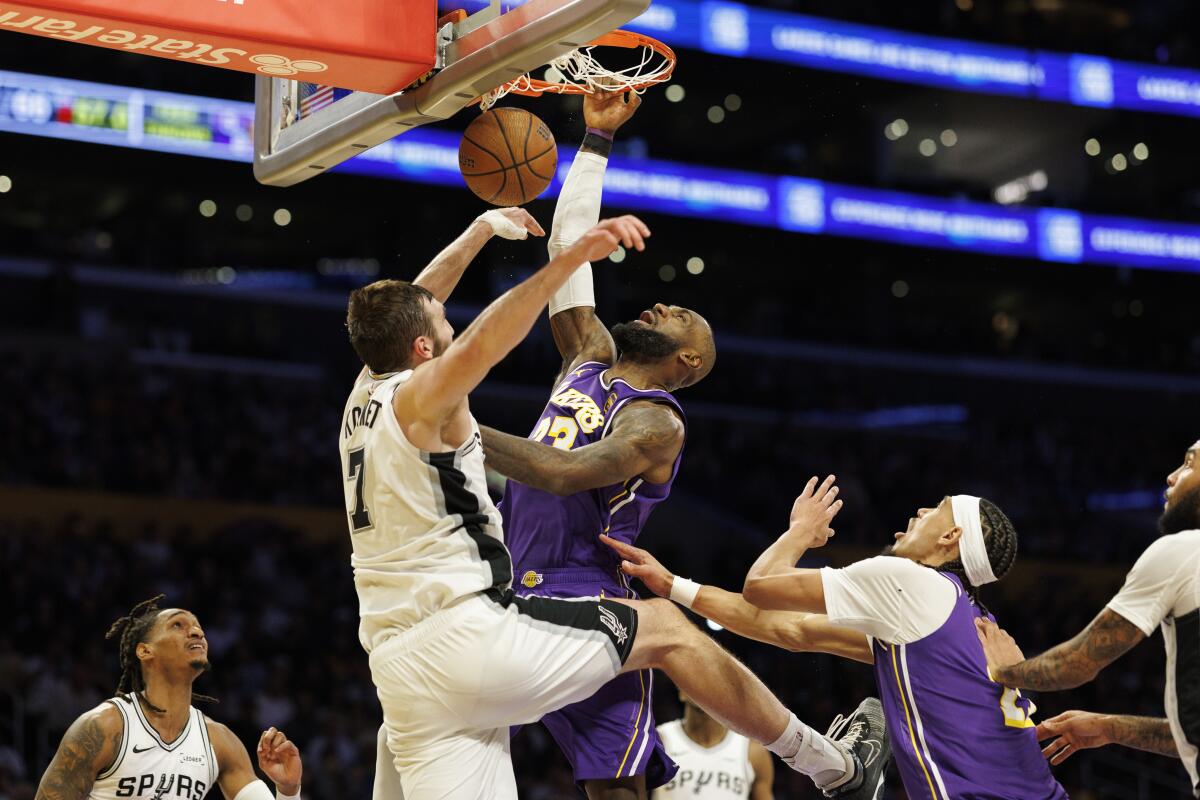LeBron James starting to look like his old self for Lakers
Welcome back to this week’s Lakers newsletter, where we’re making our interview lists and checking them twice. I have something to share: I never celebrated Christmas growing up. We didn’t do presents, trees, decorating or any of that.
What we did was basketball.
From spending Christmas Day eating my mom’s home-cooked meals and watching the NBA, I will now be at Crypto.com Arena covering the game my parents will inevitably ask about later. Talk about a special holiday gift.
LeBron James rounds into form
At this stage of LeBron James’ career, it’s not enough to just evaluate the Lakers superstar’s performance in a vacuum. So when coach JJ Redick was asked in Utah before James played his 10th game of the season whether the 21-time All-NBA honoree was “looking more like himself,” Redick didn’t have a straightforward answer.
“Well, I think you have to contextualize it,” Redick told reporters. “[He’s] ‘looking like himself’ as a 41-year-old coming off [a knee injury] and sciatica.”
Redick is premature in calling James a 41-year-old — his birthday is not until next week — but James is at least back to a version of himself. About a month since his season debut, James is starting to round into form, moving past the informal training camp and preseason period after sciatica kept him out all offseason.
James is averaging 27.6 points, 6.2 assists and 7.2 rebounds in the last five games during which the Lakers (19-8) went 3-2. His shooting percentage improved to 53.8% compared to 41.3% in his first six games.
But James is in a new era of his play. His usage rate is the lowest it’s ever been. Redick commended the superstar’s willingness to play off the ball more with Luka Doncic and Austin Reaves emerging as the team’s primary ballhandling options.
There are moments when James’ age is showing. A second jump that isn’t as quick as it once was. A dunk that looks more deliberate than explosive. Then he turns back the clock by bulldozing Luke Kornet on a vicious one-handed dunk. James, always one of the league’s best in transition, still leads the Lakers with 6.4 transition points per game.

Lakers star LeBron James dunks over San Antonio Spurs center Luke Kornet at Crypto.com Arena on Dec. 10.
(Gina Ferazzi / Los Angeles Times)
“The thing about LeBron — it’s why he’s so great — is he can play with anybody,” Clippers coach Tyronn Lue said. “So it doesn’t matter who’s on the floor, but he’s always going to be effective.”
James showed he can still carry the team for stretches when Doncic suffered a left leg bruise during the first half against the Clippers, and the shorthanded Lakers, who entered the game without three starters, still chopped the Clippers’ 22-point lead to seven in the fourth quarter.
Doncic (leg) will remain out for Tuesday’s game against Phoenix, along with Rui Hachimura (groin) and Gabe Vincent (back). Reaves (calf) is questionable as his absence has surpassed one week.
The Lakers have been short at least one player for almost every game this season, Deandre Ayton pointed out Monday after practice as he prepared to return from a two-game absence because of an elbow injury. The injuries, highlighted by James’ 14-game absence, has made Redick feel like this team’s primary identity at the quarter mark of the season is “chaos.”
Yet leadership from players such as James has helped the Lakers find calm amid the confusion.
“This is not a quiet team,” Ayton said. “… We communicate. That’s what brings closure, where you know the guy might not be out there, or superstars might not be out there, but they with us in spirit.”
James was a vocal leader even while injured. When he returned to the court, his energy was infectious in practice, Reaves said, who often marvels at how James, despite playing in a record 23rd NBA season, still feels like one of the biggest kids in the gym.
So a month after his return, when asked in Utah about how James looked in the context of his age and recent injury history, Redick didn’t hesitate to follow up.
“Pretty damn good,” Redick said.
Holiday spirit

Lakers star LeBron James stands on the court during player introductions before a game against the Utah Jazz at Crypto.com Arena on Nov. 18.
(Gina Ferazzi / Los Angeles Times)
While the NFL tried to use Beyoncé to take over Christmas last year, the games were all laughers. The NBA, meanwhile, planted its flag with a thrilling slate that had four of five games decided by six or fewer points.
“I love the NFL,” James said into the ABC camera last year after the Lakers won a 115-113 nail-biter over the Golden State Warriors. “But Christmas is our day.”
The Lakers are playing on Christmas for the 27th season in a row. James is slated for his 20th Christmas Day game, but even he’s grown tired of his personal tradition.
“I’d much rather be at home with my family,” James said. “But it’s the game. It’s the game I love. It’s the game I watched when I was a kid on Christmas Day, watching a lot of the greatest to play the game on Christmas. It’s always been an honor to play it. Obviously, I’m going to be completely honest, I would like to be home on the couch with my family all throughout the day. But my number is called, our numbers are called, so we have to go out and perform. And I look forward to it.”
The Lakers are 25-26 on Christmas Day. This year’s lineup is delicious. The Lakers at home against Houston — the only team in the league besides Oklahoma City ranked in the top five in offensive and defensive rating — is the prime-time entree. The 11:30 a.m. PST appetizer between San Antonio and Oklahoma City could be the star of the night.
Outside of James’ slightly Grinchy mood about playing, the Lakers were getting into the holiday spirit last week. Doncic gifted e-bikes to everyone in the organization, 103 in total. Jarred Vanderbilt and Jaxson Hayes held charity events. Vanderbilt and his foundation held a holiday giveback at the Boys & Girls Club last Friday while Hayes had giveaways in Compton and his native Cincinnati.
“Stuff like that just fills my heart up and makes me feel better,” Hayes said. “… Stuff like that, I just feel like it’s why God put us here, we’re here to help others.”
On tap
Records and stats current entering Monday’s games
Dec. 23 at Suns (15-13), 6 p.m. PST
Nine days after the Lakers barely survived a dramatic fourth-quarter Phoenix comeback attempt, the Lakers and Suns run it back. In the midst of a challenging portion of their schedule that featured games against Western Conference front-runners Oklahoma City, Denver and Houston, the Suns have lost seven of their last nine games, including three of their last four.
Dec. 25 vs. Rockets (17-9), 5 p.m.
Entering Monday’s game against the Clippers, the Rockets lost three of their last four games. All the losses — to Denver, New Orleans and Sacramento — came in overtime. Kevin Durant is averaging 25.3 points while center Alperen Sengun is putting together a career year with 23.2 points, 9.2 rebounds and 6.9 assists.
Dec. 28 vs. Kings (7-22), 6:30 p.m.
The Kings scored an improbable victory over the Rockets to break a six-game losing streak but remain in the Western Conference cellar. The Lakers needed a career-high 51 points from Austin Reaves to survive against the Kings on Oct. 26 without Doncic or James.
Status report

Lakers star Luka Doncic controls the ball during a loss to the Clippers on Dec. 20. Doncic sustained a left leg contusion in the game.
(Jae C. Hong / Associated Press)
Luka Doncic: left leg contusion
Doncic suffered the injury when he was kneed in the leg by the Clippers’ Bogdan Bogdanovic. He sat out of the second half and was seen on the practice court Monday with a wrap around his left calf. He is out for Phoenix, but is day to day.
Austin Reaves: left calf strain
Reaves was a partial participant in practice Monday and remained day to day. He passed the initial estimated one-week mark since being diagnosed with a mild left calf strain on Dec. 12.
Deandre Ayton: right elbow soreness
The center appeared to suffer the injury when he got tangled up with Phoenix’s Mark Williams on Dec. 14 and missed two games but will return against the Suns on Tuesday.
Rui Hachimura: right groin soreness
Redick said Hachimura started feeling pain in his hip after the game at Utah on Dec. 18. The coach expects Hachimura to be sidelined for three to five days, which leaves a Christmas Day return possible.
Gabe Vincent: low back soreness
Vincent will not be reevaluated until at least Christmas after a back issue first popped up before the game at Utah.
Favorite thing I ate this week

A meal worth savoring at Santa Monica’s Elephante: (clockwise from top) the pizza bianco, vodka sauce pasta and squash agnolotti.
(Thuc Nhi Nguyen / Los Angeles Times)
I finally crossed an essential L.A. dining experience off of my list this week. I visited Elephante in Santa Monica and very much understand the appeal.
Everyone talks about the whipped eggplant, which we got, but the vodka sauce pasta was my favorite because the pasta was perfectly cooked and the sauce had a slight smoky kick from the Calabrian chile. We also ordered the pizzo bianco, which is finished with a drizzle of hot honey and a squeeze of fresh lemon juice. An order of the squash agnolotti pasta that features sage, brown butter and walnut pesto completed the spread.
In case you missed it
Lakers want Luka Doncic, LeBron James to engage more on defense
Luka Doncic gifts more than 100 e-bikes to Lakers players, staff
Lakers eventually respond to JJ Redick’s call for change, rally to beat Jazz
Natalia Bryant gets new restraining order against alleged stalker with added protection for family
Blake Griffin, Candace Parker among Basketball Hall of Fame nominees
Lakers’ Marcus Smart fined $35,000 for making obscene gesture at official
Lakers lose Luka Doncic to injury, then fall to Clippers despite LeBron James’ 36 points
Lakers ask officials for consistency as technical fouls pile up in loss to Clippers
Lakers’ Deandre Ayton expected back Tuesday, Austin Reaves injury status upgraded
Until next time…
As always, pass along your thoughts to me at thucnhi.nguyen@latimes.com, and please consider subscribing if you like our work!



